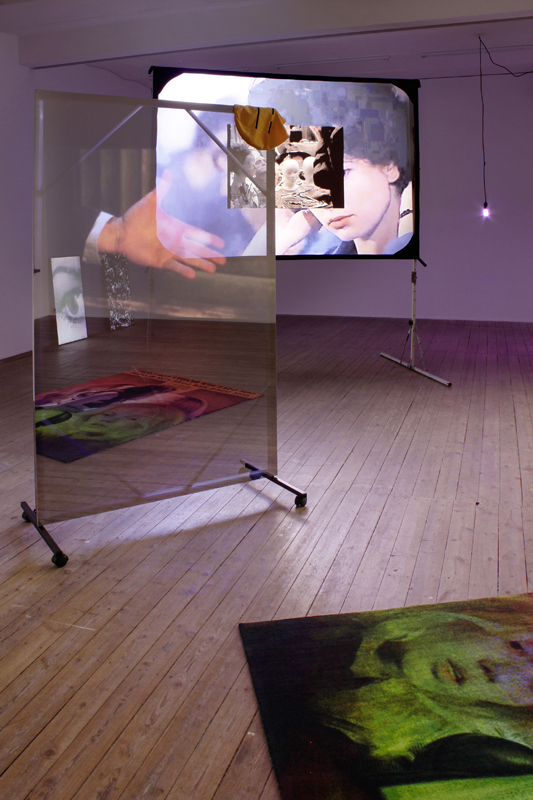
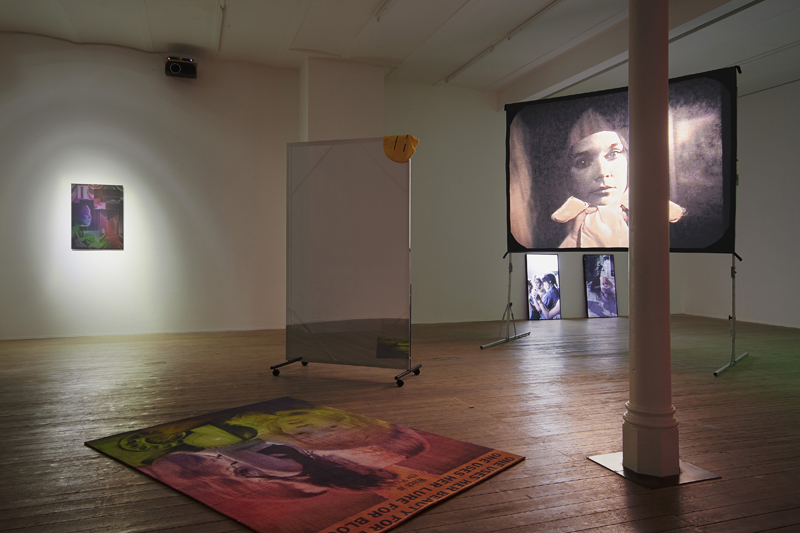
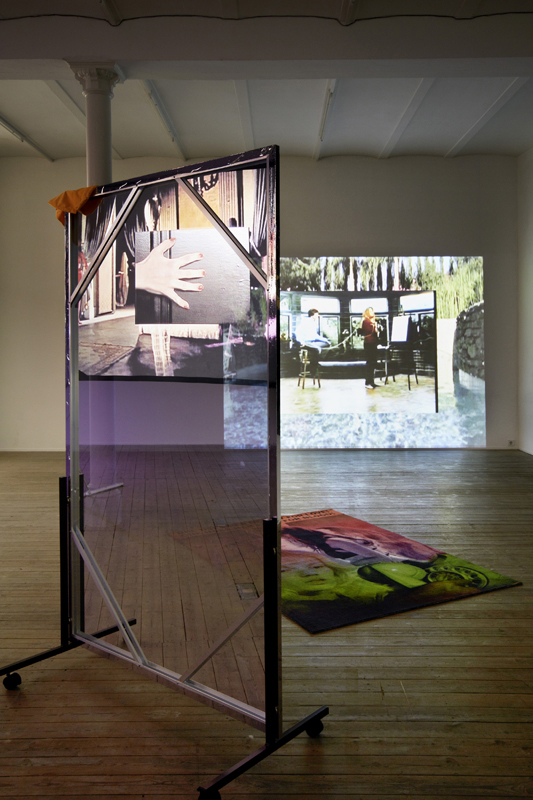
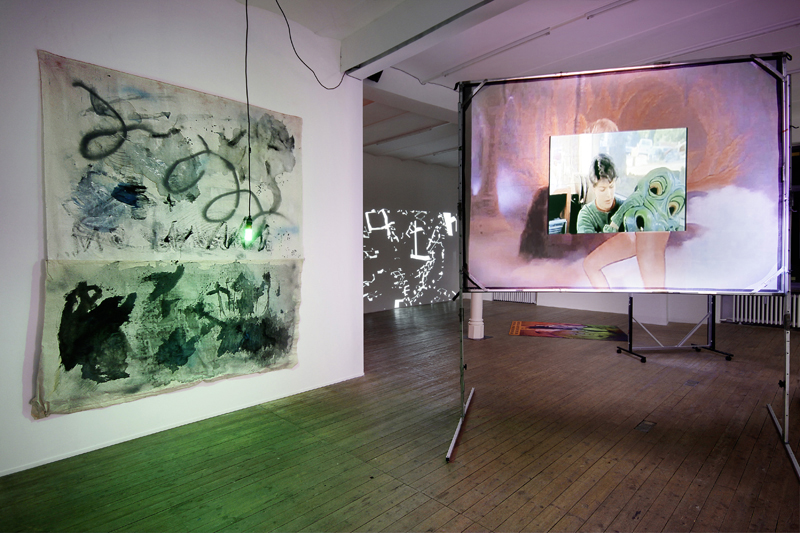
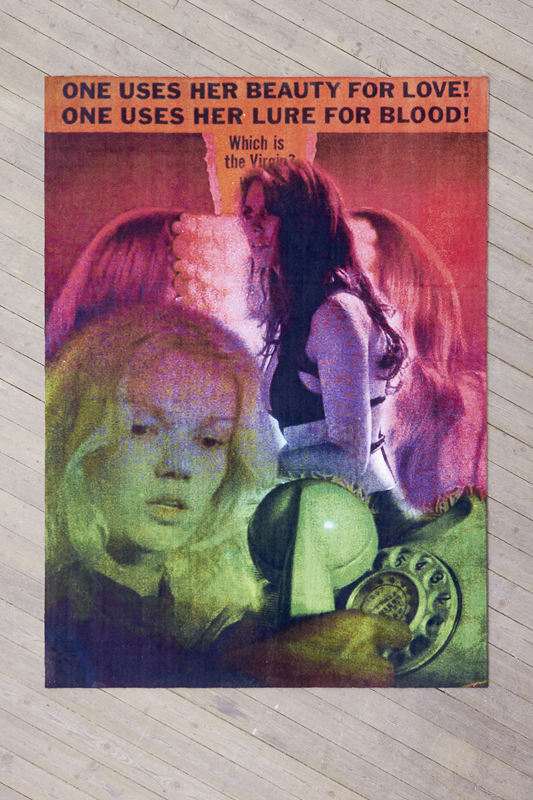
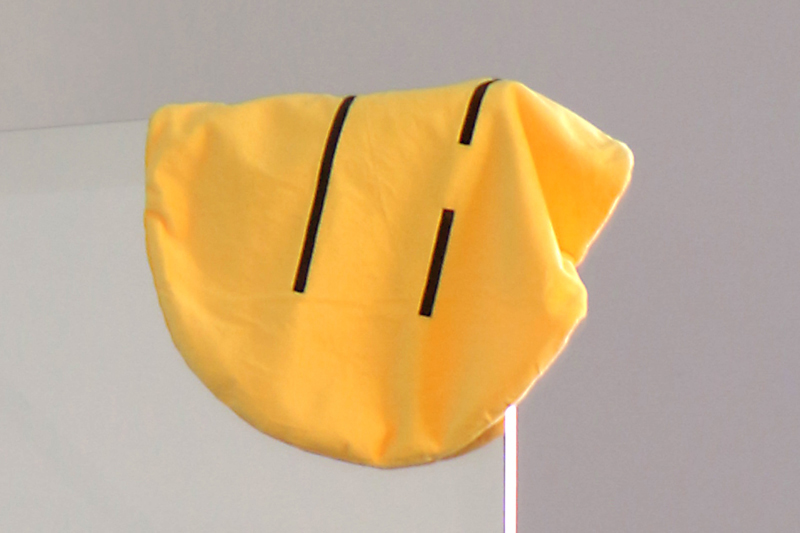
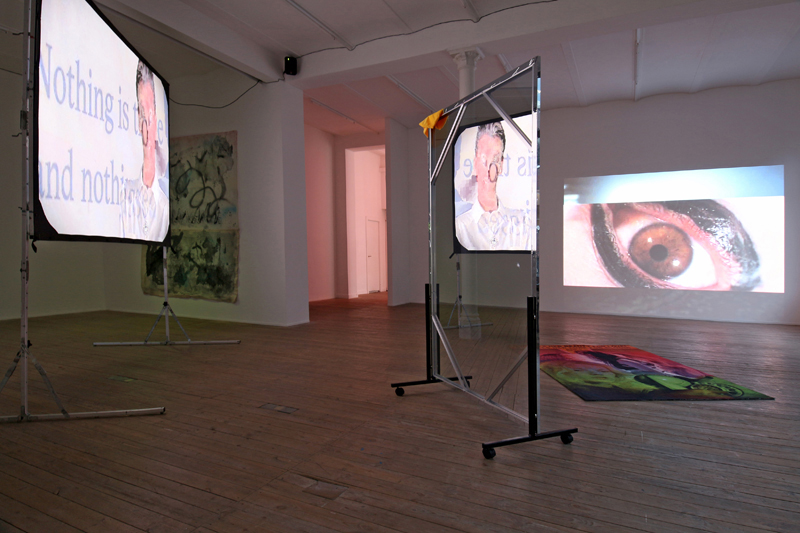



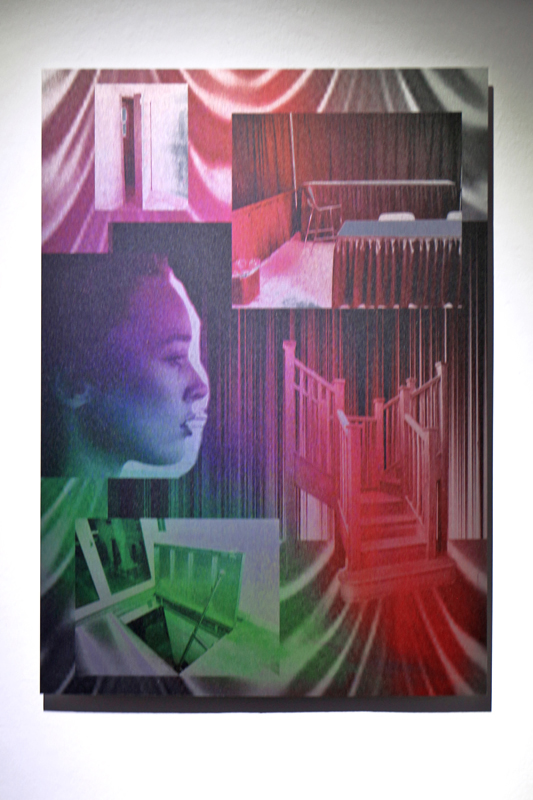


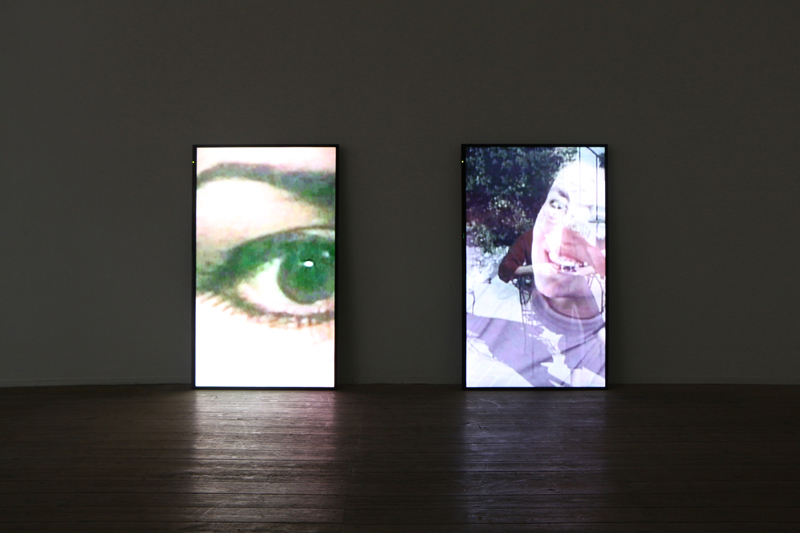
KISS TOMORROW GOODBYE
Cordula Ditz’s solo exhibition KISS TOMORROW GOODBYE creates an evocative realm of cinematic unease, drawing heavily from the aesthetic language of B-movies and campy horror films. At the heart of the show is the titular two-channel video installation from 2016, featuring large- scale projections—one displayed on a wall and the other on a freestanding screen in the center of the gallery. Rather than adhering to a linear narrative, the video adopts an associa- tive structure, focusing on clichéd depictions of femininity and the artist figure. Extracted from their original contexts yet still steeped in the visual codes of exploitation cinema, the clips are masterfully assembled into a surreal and frag- mented theater of the subconscious.
To make KISS TOMORROW GOODBYE, Ditz metic- ulously edited down material from 300 full-length films, approaching the process as a sculptor might chip away at a
block of marble. She refined the video through multiple stages, reducing its length from hundreds of hours in the timeline to just over eight minutes. This rigorous process was designed to overcome purely logical decisions, favoring an approach that channeled energy and intuition. By adopting an editing style akin to abstract painting, Ditz prioritized spontaneous associations and pictorial rhythms over traditional narrative construction. Ditz noted that as she worked through the extensive material, narrative elements and defined edges quickly became secondary, while visual qualities and recurring themes emerged as central. Each video channel has its own soundtrack, blending audio samples from the source material with synthesizer compositions. Together, the layered soundscapes create an immersive and unpredictable auditory experience, characterized by asynchronous overlaps and interfer- ences. The theme of reflection, both literal and metaphorical, recurs throughout the videos. This is evident in the mirrored surfaces and also in how the works challenge viewers to confront their own perceptions and identities.
The exhibition also included two additional filmic collages on flatscreen TVs leaning on one wall, assembled from the same material, each following a similarly intricate process of selection and reduction. On one of these screens, two scenes are blended together: a close-up of a woman saying, "This is a big test, I guess, to see if I really have some talent," overlaps with a young man sitting in a lush garden declaring, "I believe it is the most important work of my life." The juxtaposition of these statements, one hesi- tant and reflective, the other confident and assertive, creates a dialogue about ambition, self-doubt, and the societal expectations placed on individuals based on gender. The interplay of these scenes highlights the vulnerability often associated with the creative process while questioning how cultural narratives frame success and validation differently for men and women. Compared to her earlier video loops, where interventions were minimal, these new works consolidated multiple sources. In these collages, Ditz’s method of pruning films resulted in fragmented and isolated visual moments, which she then manipulated into staggered arrange- ments and new settings. Projections, monitors, and other elements of the installation multiplied the simultaneity of images, creating a layered mise-en-scène within the gallery.
One particularly striking moment in the videos features an indentured painter and a blind art dealer—an ironic and self-reflec- tive examination of authenticity within art. These characters, juxtaposed with alarmed or delirious women caught in spaces of flight and destruction, underscore the constructed frameworks of identity and the constraints they impose on individual action. The videos intertwine subjectivity, perception, delusion, and disillusionment into a vortex of visual paranoia. A recurring motif throughout the videos and installation is a computer-generated black-and-white animated grid pattern. This grid appears intermittently on the four video screens, breaking apart and reassembling itself in a rhythmic, almost hypnotic motion. Interestingly, the same pattern also appears as a screensaver on a computer in the gallery office, creating an intriguing bridge between the curated exhibition space and the behind-the-scenes environment.
This grid pattern can be interpreted as a commentary on order and chaos, the breaking and reforming of structures, and the repetitive cycles that underpin both physical and digital spaces. Its presence reinforces the exhibition's themes of layered realities, adding another dimension to the exploration of control and fragmentation.
In another evocative scene, a man holds a woman on a leash as she stands before an empty canvas on an easel. "You said you like to paint more than anything," he insists, to which she responds, "I don't feel like painting." He continues, urging her: "All you gotta do is try." This charged interaction speaks to the dynamics of coercion and autonomy, echoing the broader questions of agency and power threaded throughout the exhibition. The image of the woman on a leash becomes a powerful meta- phor for the restrictive power structures that constrain individual identity and creative freedom. Her resistance highlights the struggle to assert self- hood and agency within a framework of imposed expectations, reflecting a broader critique of soci-
etal norms around control and submission. Culminating in the poignant declaration: "Nothing is real," the videos leave viewers suspended in a space of unresolved tension and introspection.
Ditz’s meticulous attention to spatial relationships extends from her editing techniques to the exhibition’s physical arrangement. Her sensitivity to spatial dynamics is evident in both the videos themselves—where she manipulates and reinterprets the spatial structures of her source material—and the gallery’s layout. A standout element in this regard is *Mirror, Mirror / Droopy Emoji (Helpless)* (2016), a modified mirror of the type used by dancers or physical therapy patients. Covered in semi-transparent “spy foil,” the mirror reflects fragmented overlaps of the two video projections, creating complex interactions between the viewer, the artwork, and the surrounding space. Above the mirror, an empty pillow slip featuring a helpless emoji hangs like a quiet, eerie presence. Its hollow form emphasizes absence and emotional emptiness, acting as a symbolic reflection of internalized vulner- ability and detachment. This haunting detail deepens the psychological resonance of the work, encouraging visitors to consider the fragility of their own self-image as they move through fragmented reflections and layered visuals. Depending on their position, visitors might see themselves as fragmented reflections or layered within the projected imagery, blurring the lines between reality, reflection, and illusion.
Another striking component of the exhibition is *One Uses Her Beauty for Love! One Uses Her Lure for Blood!* (2016), a floor piece consisting of a printed carpet. Featuring a collage of women’s portraits and the titular phrase, the carpet transforms the ground into a visual plane. Its gradient of colors—shifting from green to pink, purple, and blue—was created not through digital processes but by collaging images of polar lights. Ditz was drawn to the natural irregularities of these photographs, including their slight graininess and random distributions of color.
The choice to use images of polar lights stems from their natural irregularities and randomness, qualities that no algorithm could replicate. These imperfections evoke a sense of wonder and unpredictability, connecting the visual with the emotional. By incorporating these naturally flawed yet captivating images, Ditz underscores how beauty and authenticity emerge through processes that defy mechanized perfection, mirroring the exhibition’s broader explo- ration of organic versus constructed realities. Adding a contrasting note to the projections and industrially produced elements, *Don’t Complain and Don’t Explain* (2015) consists of two large, unframed canvases painted in gestural strokes of watery grays and blues. The horizontal seam where the two canvases meet is deliberately exposed, emphasizing the raw physicality of the work. Despite its expressive, intuitive approach, the painting resonates with the video works by evoking a sense of the subconscious and the intangible. It offers a tactile counterpoint to the otherwise immaterial and mediated components of the exhibition.
Through its diverse range of mediums and intricate spatial arrangements, *Kiss Tomorrow Goodbye* invites viewers to navi- gate a fragmented, dreamlike landscape where boundaries between reality and illusion dissolve. The exhibition’s title serves as a poignant reminder of the transient and constructed nature of realities we inhabit—whether societal, personal, or artistic. This thematic thread unifies the varied elements of the show, prompting viewers to reflect on their own perceptions and the imper manence of identity and control.